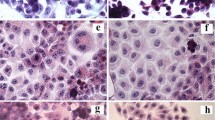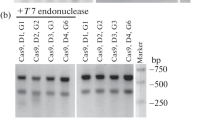Abstract
The present work describes the genetic modification of a hybridoma cell line with the aim to change its metabolic behaviour, particularly reducing the amounts of ammonia and lactate produced by the cells. The cellular excretion of ammonia was eliminated by transfection of a cloned glutamine synthetase gene. The metabolic characterisation of the transformed cell line includes the analysis of the changes introduced in its intracellular metabolic fluxes by means of a stoichiometric model. Furthermore, the reduction of lactate accumulation was attempted through an antisense mRNA approach, aiming to generate a rate limiting step in the glycolytic pathway, thus lowering the glucose consumption rate. The physiological results obtained with the transformed cells are discussed. A maximum reduction of about 47% in the glucose consumption rate was obtained for one of the transformations. However a main drawback was the lack of stability of the transformed cells
Similar content being viewed by others
References
Ausubel FM, Brent R, Kingston RE, Moore DD, Seidman JG, Smith JA, Struhl K, Albright LM, Coen DM and Varki A (eds) (1997) Current protocols in molecular biology, John Wiley & Sons Inc., New York.
Bebbington CR, Renner G, Thompson S, King D, Abrams D and Yarranton GT (1990) High-level expression of a recombinant antibody from myeloma cells using a glutamine synthetase gene as an amplifiable selectable marker. Bio/Technology 10: 169-175.
Bell SL, Bebbington CR, Scott MF, Wardell JN, Spier RE, Bushell ME and Sanders PG (1995) Genetic Engineering of Hybridoma Glutamine Metabolism. Enzyme Microb Technol 17: 98-106.
Birch JR, Boraston RC, Metcalfe H, Brown ME, Bebbington CR and Field RP (1994) Selecting and Designing Cell Lines for Improved Physiological Characteristics. Cytotechnol 15: 11-16.
Birnbaum MJ (1989) Identification of a novel gene encoding an insulin-responsive glucose transporter protein. Cell 57: 305-315.
Birnbaum MJ, Haspel HC and Rosen OM (1986) Cloning and characterization of a cDNA encoding the rat-brain glucose transporter. Proc Natl Acad Sci USA 83: 5784-5788.
Butler M and Christie A (1994) Adaptation of mammalian cells to non-ammoniagenic media. Cytotechnol 15: 87-94.
Cameron FH and Jennings PA (1991)Inhibition of gene expression by a short sense fragment. Nucleic Acids Res 19: 469-475.
Campmajó C, Cairó JJ, Sanfeliu A, Martínez E, Alegret S and Gòdia F (1994) Determination of ammonium and L-Glutamine in hybridoma cell cultures by sequential flow injection analysis. Cytotechnol 14: 177-182.
Carruthers A (1990) Facilitated diffusion of glucose. Physiol Rev 70: 1135-1176.
Chirgwin JM, Przybyla AE, McDonald RJ and Rutter WJ (1979) Isolation of biologically active ribonucleic acid from sources enriched in ribonuclease. Biochem 18: 5294-5299.
Christie A and Butler M (1994) Growth and metabolism of a murine hybridoma in cultures containing glutamine-based dipeptides. Focus 16: 9-13.
Chuppa S, Tsai Y-S, Yoon S, Shackleford S, Rozales C, Bhat R, Tsay G, Matanguihan C, Konstantinov K and Naveh D (1997) Fermentor temperature as a tool for control of high-density perfusion cultures of mammalian cells. Biotechnol Bioeng 55: 328-338.
Cockett MI, Bebbington CR and Yarranton GT (1990) High-level expression of tissue inhibitor of metalloproteinases in Chinese hamster ovary cells using glutamine synthetase gene amplification. Bio/Technology 8: 662-667.
DiStefano DJ, Mark GE and Robinson DK (1996) Feeding of nutrients delays apoptotic death in fed-batch cultures of recombinat NS0 myeloma cells. Biotechnol Lett 18: 1067-1072.
Duval D, Demangel C, Miossec S and Geahel I (1992) Role of metabolic wastes in the control of cell proliferation and antibody production by mouse hybridoma cells. Hybridoma 11: 311-322.
Glacken MW, Adema E and Sinskey AJ (1988) Mathematical Descriptions of Hybridoma Culture Kinetics: I. Initial Metabolic Rates. Biotechnol Bioeng 32: 491-506.
Glacken MW, Fleischaker RJ and Sinskey AJ (1986) Reduction of waste product excretion via nutrient control: possible strategies for maximizing product and cell yields on serum in cultures of mammalian cells. Biotechnol Bioeng 28: 1376-1389.
Glacken MW, Huang C and Sinskey AJ (1989) Mathemathical descriptions of hybridoma culture kinetics III. Simulation of fed-batch bioreactors. J Biotech 10: 39-66.
Gould GW and Bell GI (1990) Facilitative glucose transporters: an expanding family. TIBS 15: 18-23.
Gould GW, Thomas HM, Jess TJ and Bell GI (1991) Expression of human glucose transporters in Xenopus oocytes. Kinetic characterization and substrate specificities of the erythrocyte, liver, and brain isoforms. Biochem 30: 5139-5145.
Holmlund A, Chatzisavido N, Bell SL and Lindner-Olsson E (1992) Growth and metabolism of recombinant CHO cell-lines in serum-free medium containing derivatives of glutamine. In: Spier RE, Griffiths JB and MacDonald C (eds) Animal cell technology developments, processes and products, ESACT 11. (pp. 176-179) Butterworth-Heinemann, Oxford.
Jayme D (1991) Nutrient optimization for high density biological production applications. Cytotechnol 5: 15-30.
Kaghad M, Dumont X, Chalon P, Lelias JM, Lamande N, Lucas M, Lazar M and Caput D (1990) Nucleotide sequences of cDNA alpha and gamma enolase mRNAs from mouse brain. Nucleic Acids Res 18: 3638.
Kruger K, Grabowski PJ, Zaug AJ, Sands J, Gottschling DE and Cech TR (1982) Self splicing RNA: Autoexcision and autocyclization of the ribosomal RNA intervening sequence of tetrahymena. Cell 31: 147-157.
Ljunggren J and Haggstrom L (1990) Glutamine limited fed-batch culture reduces ammonium ion production in animal cells. Biotechnol Lett 12: 705-710.
Minamoto Y, Ogawa K, Abe H, Iochi Y and Mitsugi K (1991) Development of a serum-free and heat-sterilizable medium and continuous high-density culture. Cytotechnol 5: 35-51.
Moellering BJ, Tedesco JL, Townsend RR, Hardy MR, Scott RW and Prior CP (1990) Electrophoretic differences in a MAb expressed in three media. BioPharm: 30-38.
Napoli C, Lemieux C and Jorgensen R (1990) Introduction of a chimeric chalcone synthase gene into petunia results in reversible co-suppression of homologous genes in trans. Plant Cell 2: 279-289.
Ozturk SS, Riley MR and Palsson BO (1992) Effects of ammonia and lactate on hybridoma growth, metabolism, and antibody production. Biotechnol Bioeng 39: 418-431.
Paredes C, Sanfeliu A, Cárdenas F, Cairó JJ and Gòdia F (1998) Estimation of the intracellular fluxes for a hybridoma cell line by material balances. Enzyme Microb Technol 23: 187-198.
Reuveny S, Velez D and Macmillan JD (1986) Factors affecting cell growth and monoclonal antibody production in stirred reactors. J Immunol Methods 86: 53-59.
Robinson DK, Chan CP, Yu Ip C, Tsai PK, Tung J, Seamans TC, Lenny AB, Lee DK, Irwin J and Silberklang M (1994) Characterization of a recombinant antibody produced in the course of a high yield fed-batch process. Biotechnol Bioeng 44: 727-735.
Roth E, Ollenschlager G, Simmel A, Langer K, Fekyl W and Jakesz R (1988) Influence of two glutamine containing dipeptides on growth of mammalian cells. In Vitro Cell Develop Biol 24: 696.
Sanfeliu A, Cairó JJ, Casas C, Solà C and Gòdia F (1996) Analysis of nutritional factors and physical conditions affecting growth and monoclonal antibody production of the hybridoma KB-26.5 cell line. Biotechnol Progress 12: 209-216.
Sanfeliu A, Paredes C, Cairó JJ and Gòdia F (1997) Identification of key patterns in the metabolism of hybridoma cells in culture. Enzyme Microb Technol 21: 421-428.
Scanlon KK, Giao L, Funato T, Wang WP, Ton T, Rossi JJ and Kashanisabat M (1991) Ribozymic-mediated cleavage of c-fos mRNA reduces gene expression of DNA synthesis enzymes and metallothionein. Proc Natl Acad Sci USA 88: 10591-10595.
Scherczinger CA, Yates AA and Knecht DA (1992) Variables affecting antisense RNA inhibition of gene expression. In: Baserga R and Denhardt DT (eds). Antisense Strategies. Vol. 660. (pp. 45-56) New York Academy of Sciences, New York.
Smith CJ, Watson CF, Bird CR, Ray J, Schuch W and Grierson D (1990) Expression of a truncated tomato polygalacturonase gene inhibits expression of the endogenous gene in transgenic plants. Mol Gen Genet 224: 477-481.
Sureshkumar G and Mutharasan R (1991) The influence of temperature on a mouse-mouse hybridoma growth and monoclonal antibody production. Biotechnol Bioeng 37: 292-295.
Van der Krol AR, Mur LA, Beld M, Mol JNM and Suite AR (1990) Flavonoid genes in petunia: Addition of a limited number of gene copies may lead to suppression of gene expression. Plant Cell 2: 291-299.
Walder RY and Walder JA (1988) Role of RNAse H in hybrid-arrested translation by antisense oligonucleotides. Proc Natl Acad Sci USA 85: 5011-5015.
Author information
Authors and Affiliations
Rights and permissions
About this article
Cite this article
Paredes, C., Prats, E., Cairó, J. et al. Modification of glucose and glutamine metabolism in hybridoma cells through metabolic engineering. Cytotechnology 30, 85–93 (1999). https://doi.org/10.1023/A:1008012518961
Issue Date:
DOI: https://doi.org/10.1023/A:1008012518961




